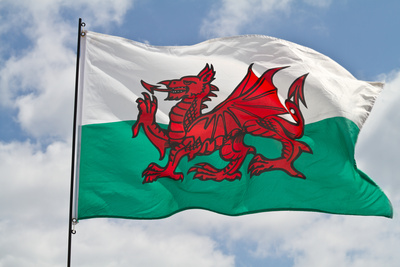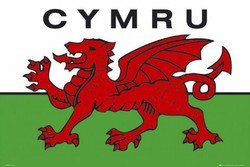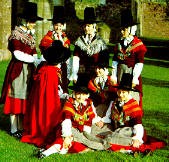The River Thames and River Cherwell meet there, so whichever water course the invaders used to gain deeper access into Britain, they would have to encounter Oxford.
Geographically, it's as true now, as it was in the time of Lludd.
Lludd did not measure the whole of Britain to find its geographical center. The entirety of the islands would have been none of his concern, and Oxford is nowhere near its meridian anyway.
What he did was visit, or send envoys, across the Isles to discover which other tribes were plagued by the 'white dragon' raiders. Then persuaded their chieftains to unite with him to see the menace off. The Oxford terrain was merely the perfect ambush site, upon which the combined British forces centered.
Lludd was told that he'd witness a 'foreign dragon' fighting on his behalf. He saw it, yet knew from the outset that the red dragon was on his side. Why would he assume that? Surely one 'foreign' dragon is as potentially destructive as the next.
This brotherhood of Celts were not one nation. They covered the British Isles in a patchwork of territories, each with its own leaders, customs and laws. A 'foreigner' could merely be a Celt from a neighboring tribe.
Moreover the Celtic warlords took the title 'Pen Dragon', chief dragon or head dragon. Hence the Arthurian legends are full of such names: Uther Pendragon and Arthur Pendragon.
The white dragon was the invaders from across the sea - the Germanic (or maybe Norse) folk intent upon plundering individual Celtic tribes. The red dragon was the collective brotherhood of Celtic nations coming together to stop them.
It was a persuasive idea which lingered, only to resurface centuries down the line. When the white dragon raids grew into an actual invasion, then the lessons of the red dragon would rise again from the mists of druidic memory.
When the invasion became a long-standing occupation, the red dragon would burn like a beacon, carrying with it all that remained and could be preserved of British culture and ethnic identity. But first there would come the prophecy and the most famous tale of all about Y Ddraig Goch.


























 St Tydecho's Churches in West Waleson 09/03/2014
St Tydecho's Churches in West Waleson 09/03/2014
 Goodies for an Outlander Premiere Partyon 03/06/2015
Goodies for an Outlander Premiere Partyon 03/06/2015
 Holocaust Memorial Day Interview with Rainer Höss, Grandson of Rudolf Architect of Auschwitzon 01/24/2015
Holocaust Memorial Day Interview with Rainer Höss, Grandson of Rudolf Architect of Auschwitzon 01/24/2015
 Romantic Valentine Gifts for an Outlander Fanon 01/16/2015
Romantic Valentine Gifts for an Outlander Fanon 01/16/2015



Comments
Arderydd is the battle where Myrddyn went mad. Later on, that story was twisted into something more by Geoffrey of Monmouth and Myrddyn became Merlin. But it seems that the original tale referred to something quite terrible to behold up there. Just another example of where folklore and legend holds hints of real history.
Unfortunately, you are very right about the suicidal tendency of Celts to not see where the enemy truly lay until it was too late. Then the divide and conquer worked with horrible effect. But the Celts managed to hold Wales and Cornwall, though the latter was too small a territory to effectively retain. Leaving it in the horrible hinterland that it's in today.
Thank you for outlining the lay of the land. I forget sometimes to explain these things for those perusing the comments.
In 547 the Angles of Bernicia [Northumberland] were pinned to the coast, but in 626 or thereabouts they swept over Northern England [having united with Deira earlier.] What happened? The battle or Arderydd in 597, which was a suicidal conflict which depleted the Britons of Northern England and Southern Scotland because of massive losses of manpower. Result: English expansion from the North East.
Sadly, the Britons spent too much time fighting each other. Without that suicidal tendency England could have been confined to the south east of the Tees-Exe line, and Wales could well have expanded right through the West of the country into Southern Scotland.
For those not familiar with the geography of Britain the Tees-Exe line is an imaginary diagona/arcl from south west to north east which roughly separates lowland from highland Britain, and to a lesser extent Celtic from Germanic, with the Celts to the north west. Part of these lands are in England [in fact much of the West of the country.] I am north west of the line, but in a lowland area, as the division between high and lowland is not absolute. As Jo says, her native Black country [part of Staffordshire] was in Wales [north west of the line] until the Mercian take over, and that is lowland
Indeed they did and yes, another Kentish man. I'd forgotten about him.
Jack Cade certainly was a Kentish Man, leader of a popular revolt in 1450. Wat Tyler was about 70 years earlier than him so whether Jack grew up with tales of Wat in his ears, anyone knows. Jack and his followers certainly did a number on London at the time, as far as I understand.
WordChazer - The Kentish Men are quite good at this. Wasn't Wat Tyler one of them? The Peasants' Revolt certainly started in Kent.
Frank - That's more nationality than ethnicity, but I do get your point.
Jo and Frank, Conn Iggulden suddenly makes a lot more sense with you talking about Kentish men. His new series is on the Wars of the Roses and includes an uprising by the Kentish men at the time of Henry VI and Margaret of Anjou.
Beswick is an old Lancashire [Manchester] name. Had the Welsh won, Lancashire would have been in Wales, so I would have been Welsh; had the Scots won at the battle of Northallerton [1138] , we might have been Scots; but the English won, so I am English. Conclusion: ethnicity is a matter of history.
I've just been reading something else that was citing that very book. Definitely one for me to check out. What's he's said there checks out with the ancient Welsh sources too, at least in the beginning - the middle of the 5th century.
The Black Country was in Powys, until the Mercians came.
Stuart Laycock wrote a good book, "Britania, the failed state." It takes the view that after the Romans left, Britain disintegrated into warring tribal kingdoms. He notes that Saxon settlements are found near the borders of tribal kingdoms, and from this he infers that Saxon were setttled to defend borders against other Britons. It seems that the struggle was not between Saxons and Britons, but between various tribal kingdoms and their Saxon mercenaries. There were Saxons and Britons on the same side against other Saxons and Britons.
In what is now England the Saxons became dominant, but in Wales the Britons were the dominant group. However, Wales was far wider than it is now. Powys stretched West of the Severn until the Mercians, whom Robyn Fleming aptly describes as good at violence, managed to capture most of its lowland territories.